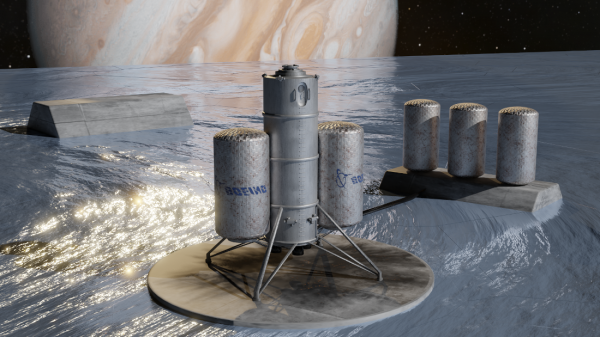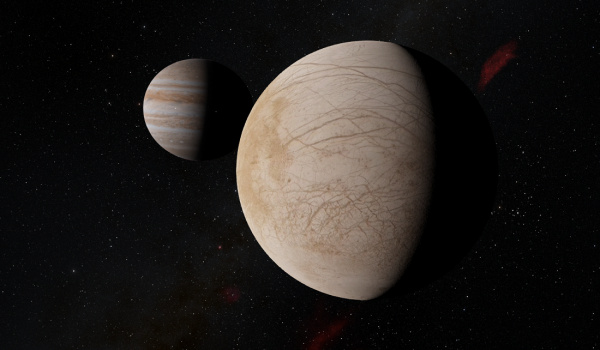BY LETTER
Europa
 Image from Copyright Lilly Harper | |
| Volatile extraction complex on the surface of Europa during the Interplanetary Age | |
Europa | |
| Type | EuEuropan |
|---|---|
| Primary, Position | Jupiter, vi (all)/ii (Galilean only) |
| Primary, Distance from | 670,900 km |
| Satellites | None |
| Gravity | 3,138 km / 0.135 G |
| year | 3.551 days / 3.551 days (tidally locked) |
| Atmosphere | Minimal |
| Surface composition | Water Ice |
| Planetology | Holotype for EuEuropan Type of world. Europa, the third largest of the four Galilean moons, is slightly smaller than Luna. Its surface is a very smooth ice-sheet, as thick as 100km in places, marked by long, crisscrossing, bright or dark linea and low, scalloped ridges, and frozen sulphuric acid. Under this is the famous Europan ocean. On the nearside Jupiter dominates the sky. |
Population: 16 billion sophonts (60% Europan, 30% aquatic provolve (various), 5% aquatic neogen (various), 3% vec (aquatic or vac-adapted), 2% all others).
Although the Europans make up the majority of the population, they are joined by a host of other aquatic sophonts (usually gengineered or bodymodded to live under the local conditions of cold water, low light, and high pressure) including Acties, Brain Kelp, Eudore, Kanuma, Madi, and various clades of sophont cephalopods including (it is rumored) a community of the famous Architeuthis sapiens order known as the Night Poets.
Government: The Chorus of Currents - a legislative group mind made up of local representatives of each Europan district, chosen by a variety of methods ranging from secret ballot to hereditary obligation, depending on the clade of the majority population in a given district. The Chorus is a member of the Solsys Organization.
Planetary Surface: The interior ocean of Europa has been re-engineered into a moon-spanning multi-level ecosystem. Conversion-Fusion hybrid reactors arranged in a three-dimensional grid throughout the ocean volume generate heat, light, and synthesized heavy elements which are harvested by specialized neumanns, processed, and excreted as the organic compounds which form the basis for the entire ecosystem. Millennia of gengineering and neogenics by the Europan natives and their allies have produced a rich and complex ecology that extends from just beneath the thick ice roof all the way to the relatively frigid high pressure depths near the moon's surface.
The outer surface of Europa is mostly undeveloped except for various communications or anti-impact point defense installations. However, a number of small communities or individual dwellings, mainly inhabited by a mix of vecs, humans, and others, are dotted here and there across the landscape. Most who live on the surface either enjoy the isolation, the ever changing view of Jupiter and its moons, or both. Virtually all surface inhabitants employ bodymodding or enhanced medical systems to deal with the effects of Jupiter's radiation belts.
Orbital Space: Europan low orbit is occupied by a large orbital ring, which supports eight beanstalks connecting to the surface, magnetic levitation systems to launch or catch Transys capsules, and infrastructure for travelers of all sorts from bionts to vecs to sophtware. Various small habitats are incorporated into the ring, mostly as transit and transfer facilities for those that may want them. A few are used by sophonts who, like those who live on the surface, wish to be able to view the Jovian system directly, but prefer to do so from orbit.
History: Long believed to be a habitable home for life, Europa excited great interest during the Information and early Interplanetary Age. The predicted inner ocean was found to exist under the massive ice sheets, but turned out to be quite lifeless. A famous hoax perpetrated in 352 by White Fraction geneticists actually caused a media sensation until the real origin of the Europan organisms was uncovered.
 Image from Steve Bowers | |
| Europa and Jupiter | |
When it reached the top of the slope, the buggy emerged from the kilometer wide canyon that seemed to extend endlessly into the shadows behind the vehicle, between ice cliffs hundreds of meters high. Four tall wheels supported a large cabin, divided between the rear compartment — full of lockers — and the cockpit which was topped by an armored windshield shaped as a bubble. It was in rather good condition. Odys had hung his Centillion-Provolves Buddha amulet from one of the curved metal frames that supported the spheroidal window of the cockpit. All the main systems were operational, as the glitches resulting from damage made by previous malware attacks affected only sub-systems Odys had no need for.In the late 5th century Jovian Genetics & Adaptation began the process of tweaking organisms, including humanoids, to live in the Europan seas. Shortly after, the technoplague destroyed the terran habitats on the surface, but the geneered life survived and flourished in isolation, until being discovered some centuries later by the new Federation. The history of Europa then became the history of the relationship between the Europans (or Europeans) and the Federation "BeyondWorlders" as they were called by the Europan tweaks.
The full extent of the sky finally came into view over him, through the transparent ceiling of the bubble. Jupiter covered over five hundred times as much of Europa's sky as Luna does Earth's. A tiny sun was emerging from behind the dark and massive figure of the gas giant, its atmosphere producing a glowing arc of red twilight all around it. As far as the eye could see, the entire icy landscape, with its buttes, clefts, cirques and craters was illuminated in a faint red-orange hue. The uncanny glimmer made the moon look like it was ablaze by virtue of an eerie frozen fire. -Snapshot From 'Ocean Untamed', 627 AT
Eventually a multicultural interface developed on the surface, chiefly sociologists, biologists, and traders. Europa was accepted into the Federation as a member world with full planetary ownership.
Back to Solsys
Related Articles
Appears in Topics
Development Notes
Text by M. Alan Kazlev
Updated 5 November 2021 by Orion's Arm Editors
Initially published on 24 October 2001.
Updated 5 November 2021 by Orion's Arm Editors
Initially published on 24 October 2001.
Additional Information
Image 'Volatile Extraction Complex' copyright by Lilly Harper used with permission. Please contact her for conditions of re-use at https://beaconsinthedark.wordpress.com/.






